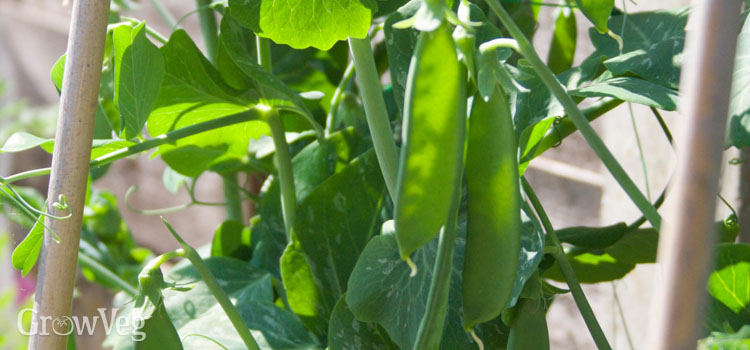How To Tie Up Beans In Garden
Supports for Climbing Beans and Peas

Vertically growing plants are an attractive feature of many vegetable gardens as well as being an excellent space-saver. Climbing peas and beans (especially pole beans) can be some of the most productive plants you can grow, but providing strong supports for these plants is essential. When the seedlings first emerge they may seem small and delicate but by the time the vines have wound their way up to six feet tall with a thick mass of leaves and pods the supporting structure will have to be strong enough to take the weight and sturdy enough to survive winds.
A huge variety of supports can be bought or built for these crops and the best option will depend on materials, time, budget and personal preferences. For ornamental gardens it will be important to consider the aesthetic aspects as vertical supports often draw the eye in a garden and can make a big difference to the appearance. At the other extreme, in community gardens practical recycled solutions often rule and with a little ingenuity all sorts of 'junk' materials can be used to make good supports.
Materials to Use
The first decision when creating supports for climbing plants is what they will be made out of. Here are the most common options:
- Bamboo canes: These have the advantage of being perfectly straight up to relatively long lengths and are very resistant to weathering, lasting for years. However, unless you can grow bamboo yourself over many seasons they can be costly as they are usually imported all the way from China.
- Hazel or other coppiced wood: Here in the UK, hazel can easily be coppiced to provide many strong flexible hazel rods. Traditionally, hazel coppices were cut every 7 years reaching several metres high but gardeners rarely require this length and can cut it more regularly to grow their own attractive garden supports.
- Spare Sticks and Branches from Trees: Instead of hazel it's also possible to use branches trimmed from trees in your garden. However, these are less likely to be as straight or flexible and may be harder to fasten together into a strong structure.
- Fencing: Any kind of wire fencing can be used for climbing plants as long as it is sturdy enough. If you have wire fencing along the edge of your garden already it's the perfect support. If not, recycled fencing can be put to good use when combined with strong poles.
- Recycled Materials: In community gardens, left over building materials such as steel rebar (the steel supports used in reinforced concrete) are often used as they are easy to drive into the ground. Spare timber can also be made into sturdy frames.

When using poles, two beans or pea plants are often grown up a single pole. However, having a pole every 6-8 inches is quite costly, so it's quite common to add something else for them to climb up so that the gap between poles can be increased:
- Netting: Most types of netting will do, although the smaller the holes the harder it is to remove the dead stems at the end of the season. I use Pea and Bean Netting which has a large weave of 12.5cm (5") and is easy to drape over a structure of poles.
- String: Alternatively, garden twine can be used as long as it is tied firmly and does not disintegrate in bad weather. It's too late to find this out just before harvest when the weight of the plants snaps the string (I write from experience!)
- Wire: More tricky to secure but very strong, wire is good for semi-permanent structures which can be moved around the garden each season.

Building the Supports
Once the materials have been collected it's time to get building. There are many types of structure:
- Double row: the classic structure is to plant two rows of beans or peas about 1 foot (30cm) apart and to stick canes in each side, tying them together at the top with string. I often use this method and add an extra cane along the top with a supporting 'guy rope' string at each end to strengthen the whole structure.
- Wigwam: in this arrangement plants are placed in a wide circle and the canes are either tied at the top or are fastened into a cane ring. This can look very attractive as well as adding strength in all directions. However, the ground in the middle of the wigwam is lost unless a quick growing crop is planted there before the climbing plants get going.
- Arch: One of the most beautiful designs, especially when peas are flowering, is to grow them up over an arch between beds or over a walkway. Arches can be costly to make and unless they can be moved they limit crop rotation to the legume and squash families (if you only want to grow edible climbing plants) but those may be sacrifices worth making if you enjoy the display. Attractive steel arches are available from many gardening stores and suppliers.
- Wall or Fence: Climbing plants need something to wind their tendrils around so growing them up a wall or solid fence usually requires trellis or netting to be fixed to it. As long as the location receives at least 4-5 hours of sunlight a day this can be a great space saver and has the added advantage of not casting shade on other areas of your garden.
- Central Support: Rather like the wigwam structure a single strong pole can be the anchor for many lengths of string radiating out to pegs driven into the ground. To support the vines this needs to be strong and taut.
< All Guides
How To Tie Up Beans In Garden
Source: https://www.growveg.com/guides/supports-for-climbing-beans-and-peas/
Posted by: lomaxbuting.blogspot.com

0 Response to "How To Tie Up Beans In Garden"
Post a Comment